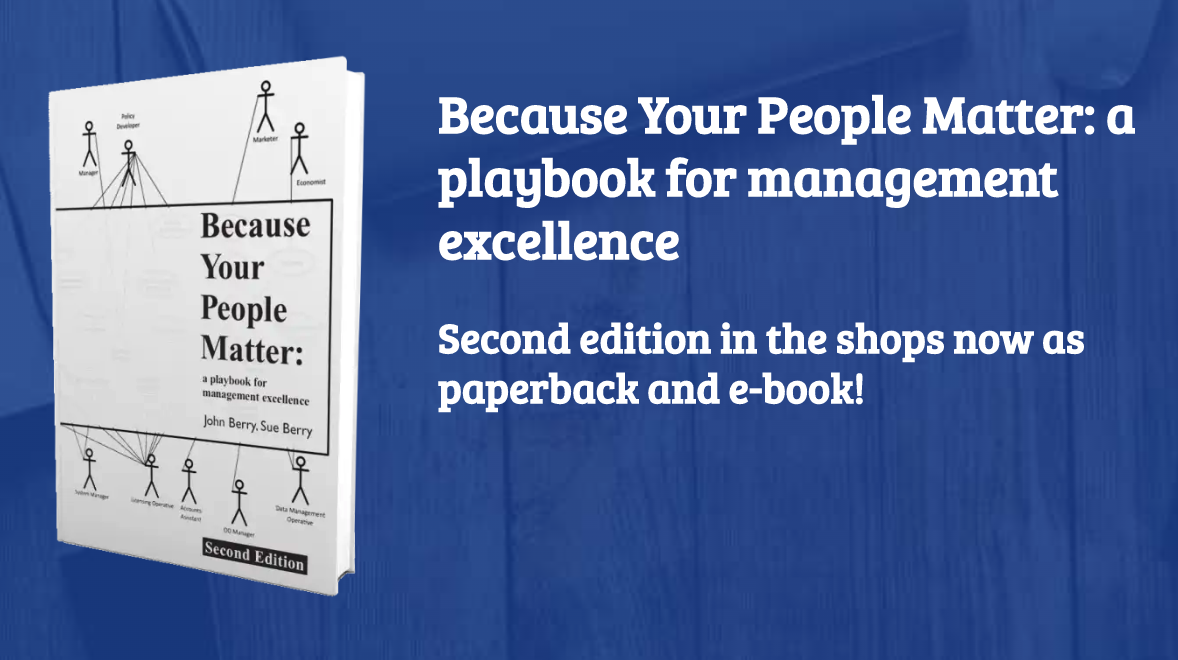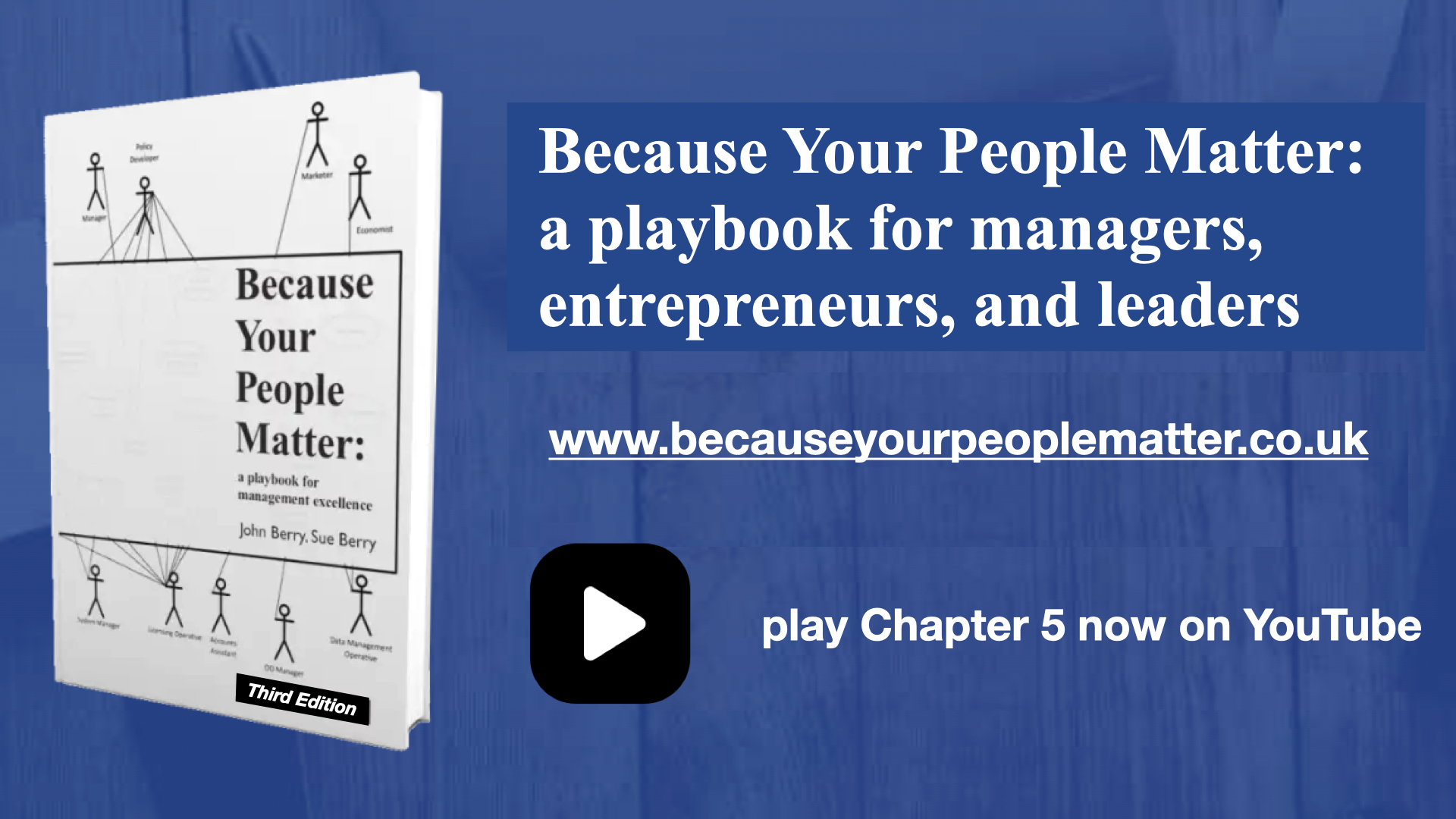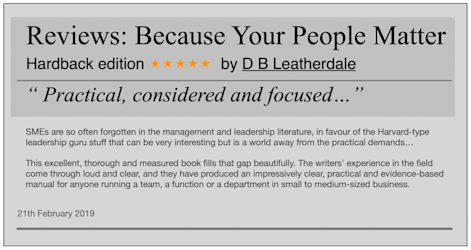One of twelve chapters of our book, Because Your People Matter: a playbook for managers, entrepreneurs, and leaders, serialised here.
Managing People: getting the best performance out of employees day to day
Written by John Berry & Sue Berry on 23rd January 2023.0
4 min read
Chapter 5: Managing People
Chapter Summary
 This chapter has dealt with what many would describe as ‘people skills’. Unfortunately, often, people skills are learned on the job, forgetting, or ignoring the science behind the building and maintaining of relationships to secure employee performance. In this chapter we’ve introduced much of this theory in the hope that managers can mix theory and practice to build their own management competence.
This chapter has dealt with what many would describe as ‘people skills’. Unfortunately, often, people skills are learned on the job, forgetting, or ignoring the science behind the building and maintaining of relationships to secure employee performance. In this chapter we’ve introduced much of this theory in the hope that managers can mix theory and practice to build their own management competence.
Firstly, we describe a linear feed-forward model of employee performance that starts with the job the employee does. The job motivates and creates behaviour. Behaviour can, all other things being equal, cause performance and, of course, performance leads to the achievement of outcomes. If only it were that simple!
For performance using the feed-forward model, the manager must set up the right conditions.
Adding feedback
But as systems engineers would say, this is management operating in ‘open loop’ configuration. The manager sets things up and hopes that the employees are suitably motivated, have the right tools and will then perform. But what if they don’t?
We argue that the manager must make use of feedback. If performance is not achieved, an error message that there’s something wrong must trigger corrective action by the manager. We then introduced the feedback control model. Here, the manager observes the performance and measures the outcomes realised. The manager then determines appropriate interventions that will recover the performance and achieve the outcomes desired.
The feed-forward and feedback models are fundamental to managing people.
Antecedents of motivation
 Employees, in taking a job, seek task variety. They expect to make use of all that they’ve learned. And they expect to be treated with respect. Ultimately, work must give them purpose and meaning. The manager must therefore design the job with all that in mind.
Employees, in taking a job, seek task variety. They expect to make use of all that they’ve learned. And they expect to be treated with respect. Ultimately, work must give them purpose and meaning. The manager must therefore design the job with all that in mind.
If the work and the working conditions that the manager has organised are right, the employee will commit to the firm. Commitment is the first stop on a continuum from commitment through motivation to engagement. There are three types of commitment, two involve obligation while one involves affect. Managers should seek affective commitment in employees - emotional commitment in which the employee expresses desire to work for the firm. Affective commitment is for the manager to win.
If conditions are right, the job will cause the employee to be motivated.
And if the right conditions are in place to enable learning and achievement, super- motivation or engagement can ensue. We argue that super-motivation is not needed in all. But certainly, it’s essential that key employees – those forming the kernel of the firm’s capability – are engaged.
Culture and climate
The feed-forward model is overly simplistic in assuming a cascade from job through motivation to behaviour and performance. It ignores the environment in which the job and jobholder exist. Part of that environment is the culture created by colleagues and managers – and in part by each employee’s home life. We discuss the application of models for culture definition in the context of making change to culture, thereby influencing employee motivation.
Managers must learn to use emotions in their management lives. And we give a model that allows managers to understand and direct emotions.
Using power
 We discuss also how power plays in the firm – how the manager gets their way. We note the existence of P-power and S-power, and we suggest that it’s S-power that managers need in abundance.
We discuss also how power plays in the firm – how the manager gets their way. We note the existence of P-power and S-power, and we suggest that it’s S-power that managers need in abundance.
Then we look at how groups form and contribute to getting things done. We suggest, perhaps controversially, that few firms need teams. All that’s needed is cooperation between employees and hence the building of cooperative groups. Employees can learn to contract with one another, thereby becoming reliable colleagues. The extreme effort needed to create teams is unnecessary in all but a few instances.
Bias and equality
And finally, we discussed the huge topic of bias. We suggest a general model for understanding. We then focused on one of the most common and damaging biases, prejudice. Prejudice results in inequality so much so that the UK Government has implemented statute – the Equality Act 2010 - to try to counter it.
In the last sections we set out how one outcome of bias, the gender pay gap, is measured. Gender pay-gap reporting is now mandatory for larger firms. In closing, we make the statement that gender inequality is a societal problem.
In summary
In summary, management is about understanding the mechanisms – what, for a given employee, will cause performance. Once those variables are known, the manager can start the management ‘engine’ to sense outcomes and launch interventions to maintain performance to that needed. Using this model, management loses its myth and becomes a science that can be learned by all.